Marketplaces flow manager
Fast, reliable flow management
Sellermania includes an extremely advanced feed manager, called Smartmap, which fulfills all the requirements for being listed.
Stock synchronization
Marketplace inventory is constantly updated in a variety of ways, depending on the way you work.
Order automation
Whether you have one or several feeds, simple or complex business rules, automate updates with ease.
Choose a "Platform" flow manager
When it comes to marketplace flow management, all flow managers are not created equal. Platform” flow managers , like Sellermania, go further than pure flow management, and add advanced functionalities to perform on marketplaces. These are two different ways of thinking about selling on marketplaces. Learn more about these differences.
Our 15 years’ experience on marketplaces has enabled us to develop our platform to cover all the areas necessary for a successful merchant: catalog flow, inventory synchronization, order management, pricing and matching.
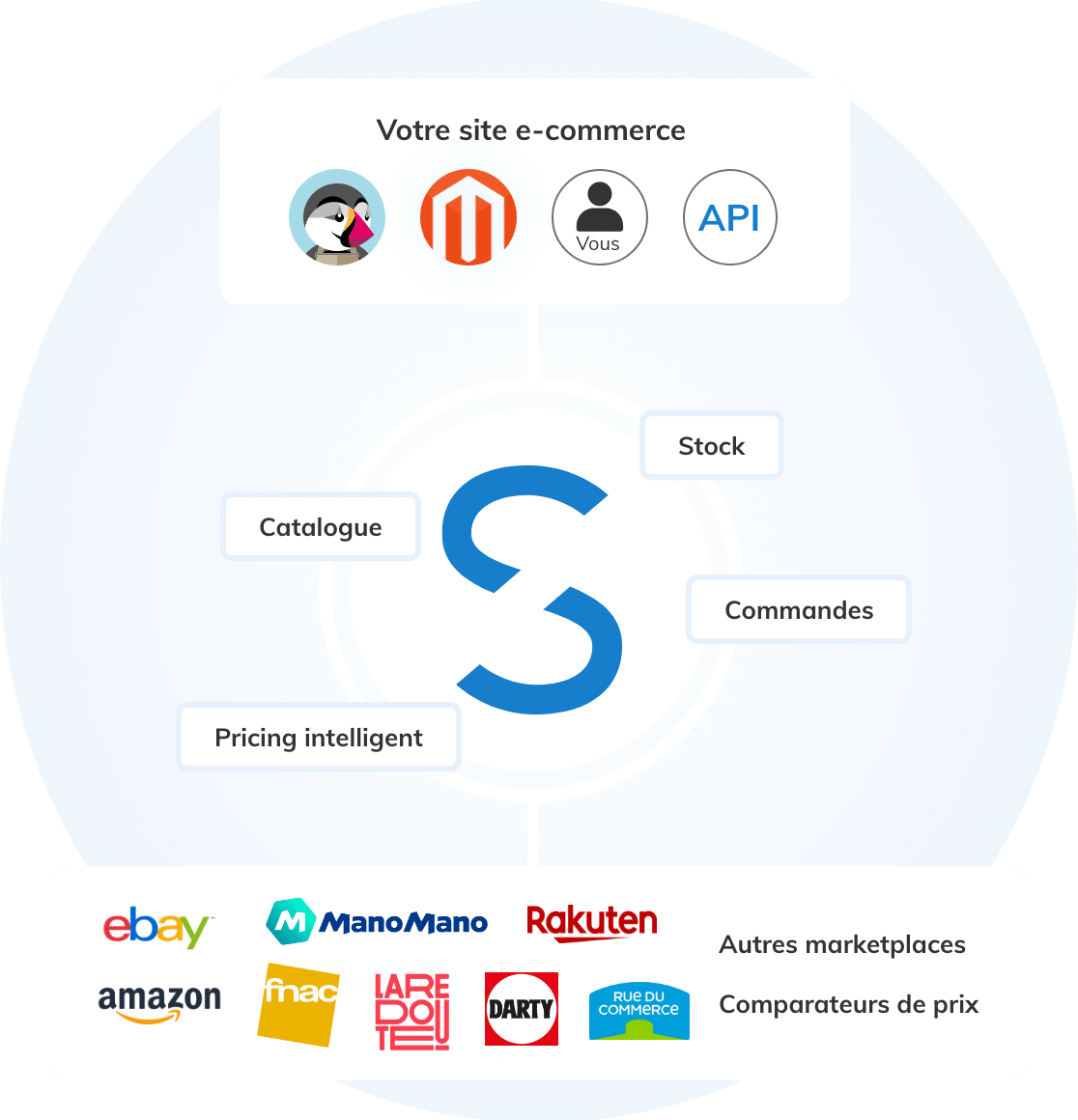
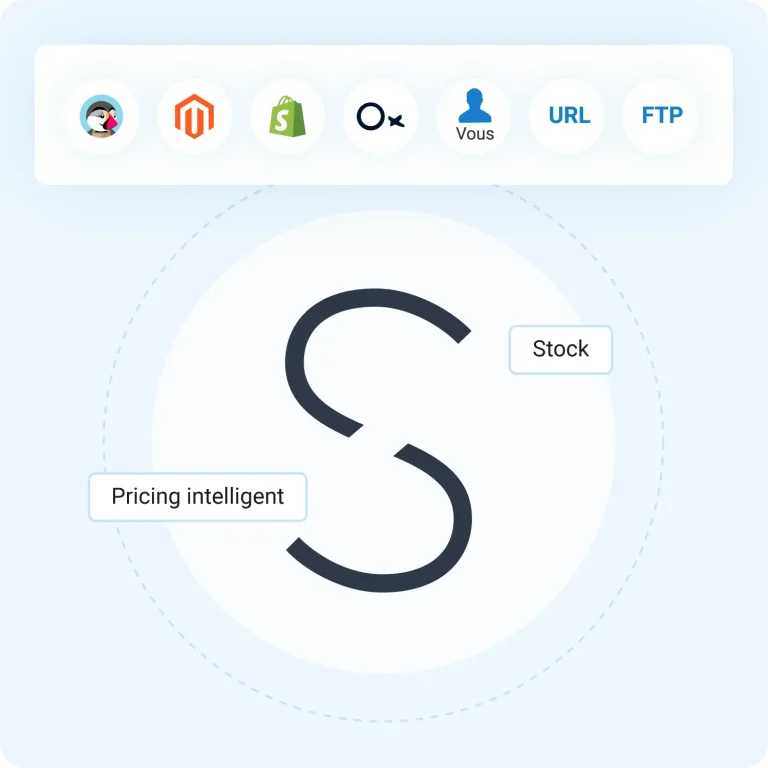
Your catalog feed can come from anywhere
You have a website using Prestashop, Magentoor Shopify, there are free Sellermania-compatible modules for exporting your product catalog quickly and efficiently.
If you’re using another solution(Oxatis, in-house solution…), or a PIM or database, your catalog can still be used as a product feed, accessible via a URL or FTP.
Adaptation to your product flow
Flexibility: Smartmap is a patented feed management software solution that enables you to adapt your file or feed to the most exacting requirements of all marketplaces. Think of Smartmap as a gigantic macro, which transforms your data to match your categories, formats your information, cleans up your catalog, until it’s exactly compatible with marketplaces.
The power of Smartmap, with its 50 customizable functions, allows you to adapt to almost any situation and send your products to marketplaces, price comparison sites, retargeting…
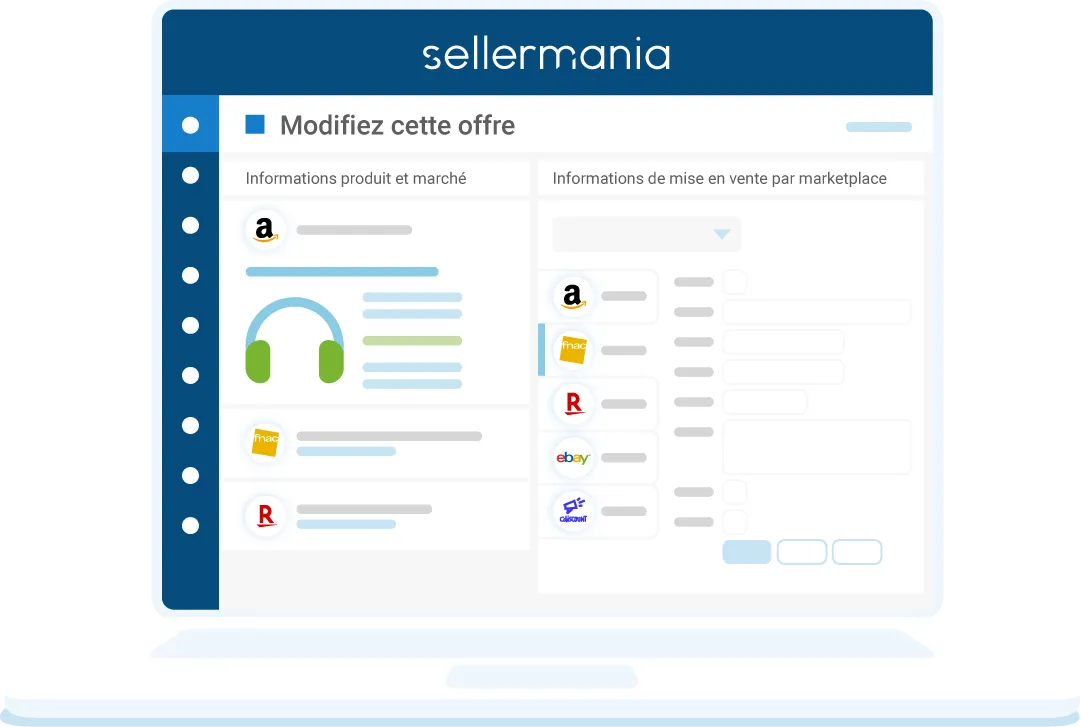
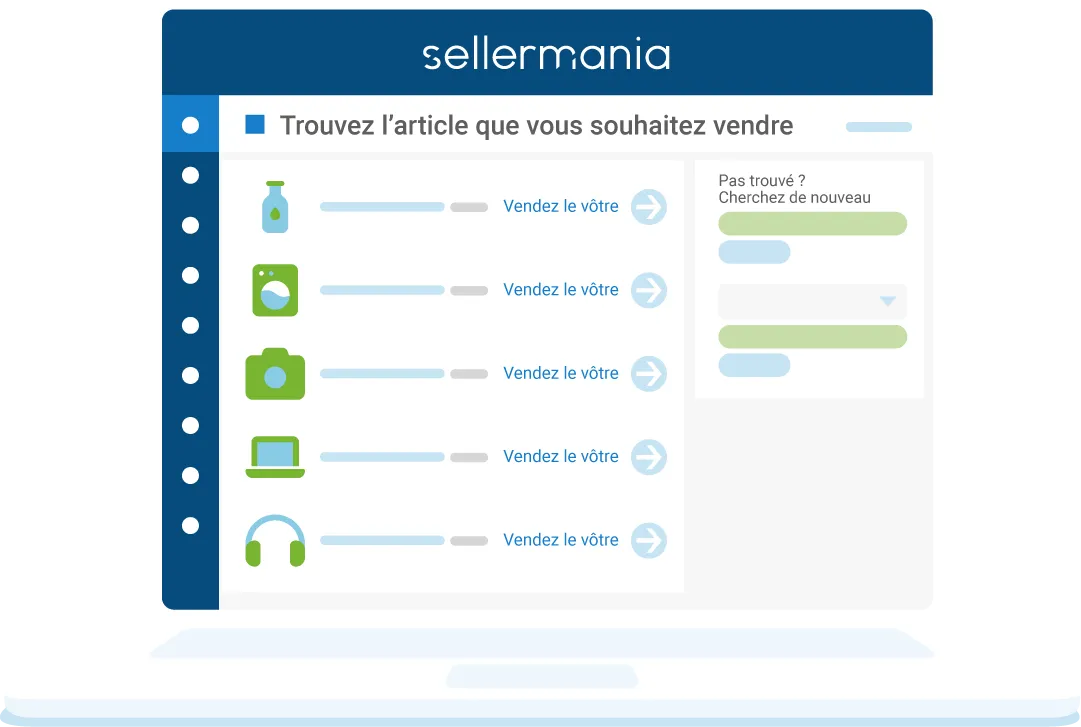
Matching and product creation
Whether your products are already listed on marketplaces (matching) or not yet (creation), Sellermania’s software enables you to easily list your catalog, thanks to its marketplaces feed management solution.
Matching is child’s play, and can be done without a file, directly in Sellermania: the “EAN finder” immediately shows you the product reference number on each marketplace.
The creation process is ultra-flexible and comprehensive, and can be adapted to virtually any situation, whether you have one or several feeds.
With or without website
If you have a website , you can easily connect it to Sellermania, so that products added to your site are automatically transmitted to marketplaces. Stocks are constantly synchronized between your site and all marketplaces.
If you don’t have a website, Sellermania is a one-stop, multi-marketplace “Seller Central”. The interface allows you to easily manage your entire marketplaces activity: adding products, inventory management, order management, file import/export…

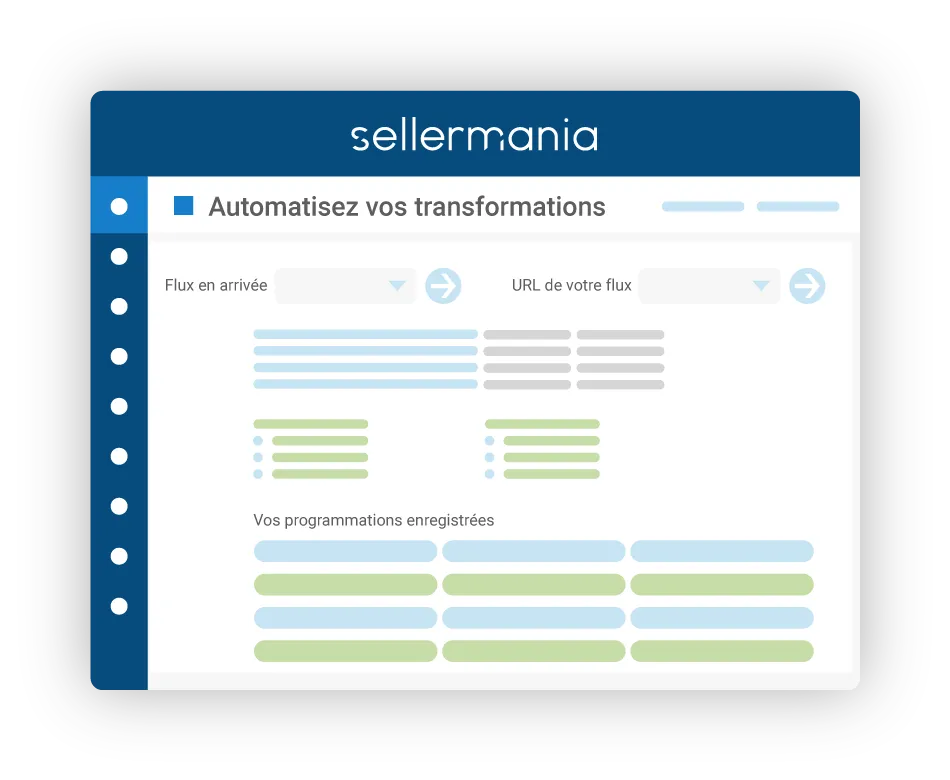
Automate and save time
Automate inventory updates, prices, file uploads and exports. Sales made on one marketplace automatically reduce inventory on all other marketplaces. As a result, your stocks are up to date everywhere.
Automatically retrieve orders from your website, export them to your logistics, automatically transmit order tracking numbers.
Our APIs enable you to fully automate the sales cycle, in real time.
These features set Sellermania apart from the competition, as our benchmark of the best feed managers shows.
Démonstration
Discover how Sellermania will revolutionize the way you work
- 100% free, no-obligation demo
AVIS CLIENTS
Our customers' opinions
9 out of 10 customers
Would recommend to a friend
96%
Are satisfied or very satisfied
87%
Increase their sales
96%
Save time

Sellermania in figures
6 questions about flow managers
FAQ
How does the feed manager create products for marketplaces?
The marketplaces flow manager lets you create mapping rules to optimize your product flow and meet all the requirements of marketplaces. Several types of rules exist depending on the complexity of what you want to do:
Simple mapping rules

This type of rule is used to recategorize the products of the feed. Here, Fnac has a “Multi-activity Swings / Gantry” category.

This type of rule is used to transform the content of the feed. Here for example, the rule removes the HTML code from the description, because HTML is prohibited on the FNAC marketplace. Numerous transformations are possible: “search – replace”, “delete”, “concatenate”, “add” and so on. At Sellermania, our flow management solution is equipped with more than 50 functions that allow you to transform your product flow in depth, and adapt to all situations.

What is a flow manager?
Productfeed manager, marketplaces feed manager, marketplace integrator, feed aggregator: this is a tool that enables e-merchants to export their product feed to sell their products on marketplaces, price comparison sites, social networks, retargeting platforms, etc.
At Sellermania, flow management is our daily business: e-merchants use our flow management technology to optimize their activity on marketplaces.
When you have an e-commerce site and want to export the products from your site to marketplaces, this goes through a product flow, exported daily from the e-commerce site. The marketplaces feed manager will enable you to distribute this product feed to the various channels you’ve targeted.
Each marketplace has its own requirements in terms of referencing and creating a product catalog: the references must be categorized according to a standard (“Mobile phones”, “Hands-free kit accessories”, “Tablets”, etc.), the products described by attributes specific (“Power”, “Weight”, “Memory”…).
The product flow of your e-commerce site will have to be adapted and optimized to meet these requirements and allow the creation of catalogs on marketplaces and other channels.
The marketplaces flow manager , at Sellermania for example, consists of a series of rules, called mapping rules , which allow you to adapt your product feed to marketplace catalogs. These rules are to be configured only once, which allows to automate the processes thereafter, and create your new references automatically on the marketplaces.
A feed manager, also known as a feed aggregator, is becoming essential for online sales on multiple marketplaces, in order to optimize and automate sales. It facilitates the daily management of online sales on marketplaces.
How does the marketplaces flow manager handle order flows?
Just like product creation, order management can be centralized on your site, thanks toorder import via the workflow manager platform. This means that when you receive an order from a marketplace, it passes through the flow manager before arriving in your management system (your website, for example, or your ERP).
Once the order has been processed and dispatched, your management system sends the order status update and package tracking number back to the flow manager, who in turn transmits the information to the marketplace.
In other words, the flow manager enables you to centralize orders from marketplaces in your system, and handle sales from marketplaces “remotely”.
What is a product feed?
It contains all your references, with two types of information: product information, which describes the item sold, independently of the merchant, and offer information, specific to the merchant, which describes the sale price, stock, lead time, etc.
Descriptive information of the products:
- EAN code
- Title
- Mark
- Description
- Image link
- Category
- Keywords
- Specific attributes used to describe the article
- etc.
Offer information:
- Quantity in stock
- Selling price
- Delivery time
- Terms of delivery
- etc.
In red, product information, and in green, offer information:
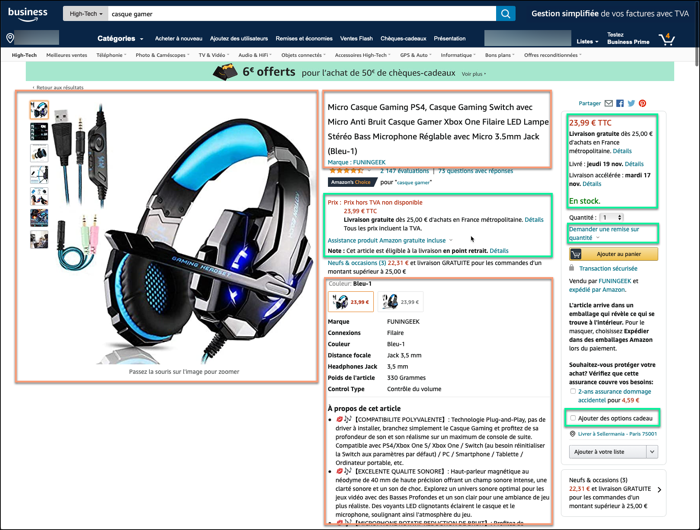
It is important that product information and offer information are clearly distinguished. Shipping costs should not be found in item descriptions, or your website address on product images. The descriptive information of the products will be used to create article sheets on the marketplaces sites, and they must therefore be independent of your offer information, and be content to describe the items sold.
Some marketplaces ask for a relatively high level of detail when describing items, multiplying attributes such as length, weight, gender, color, and so on. It can quickly become complicated if the product feed does not contain enough information to fill these attributes. Likewise, if this information is not easily identifiable in the product flow, because it is mixed in the description of the items, for example, this makes the integration complex.
The richer the product flow, the easier the integration into marketplaces will be.
The format of the file itself, whether CSV or XML, is generally of little importance, although CSV is often more convenient.






